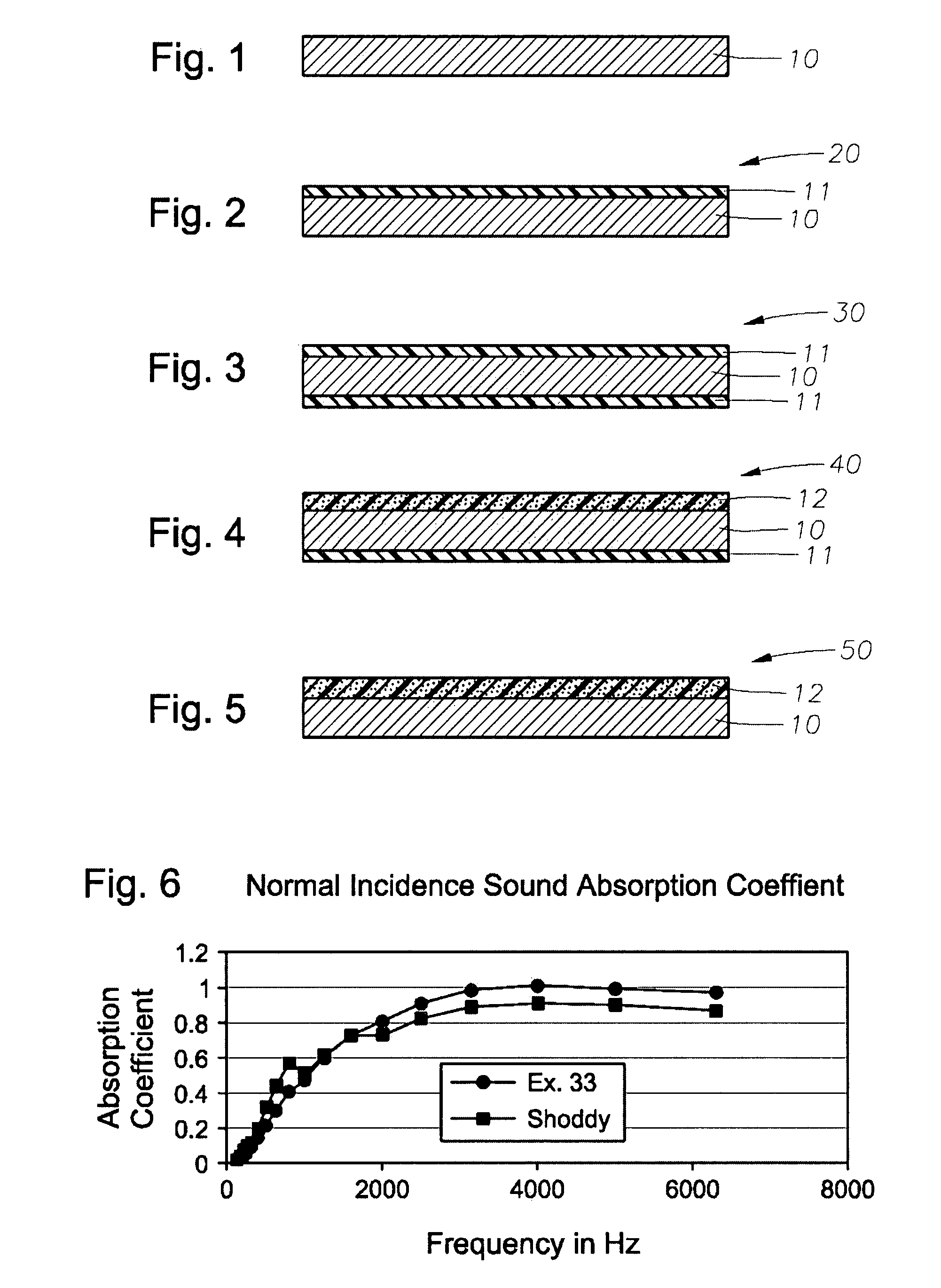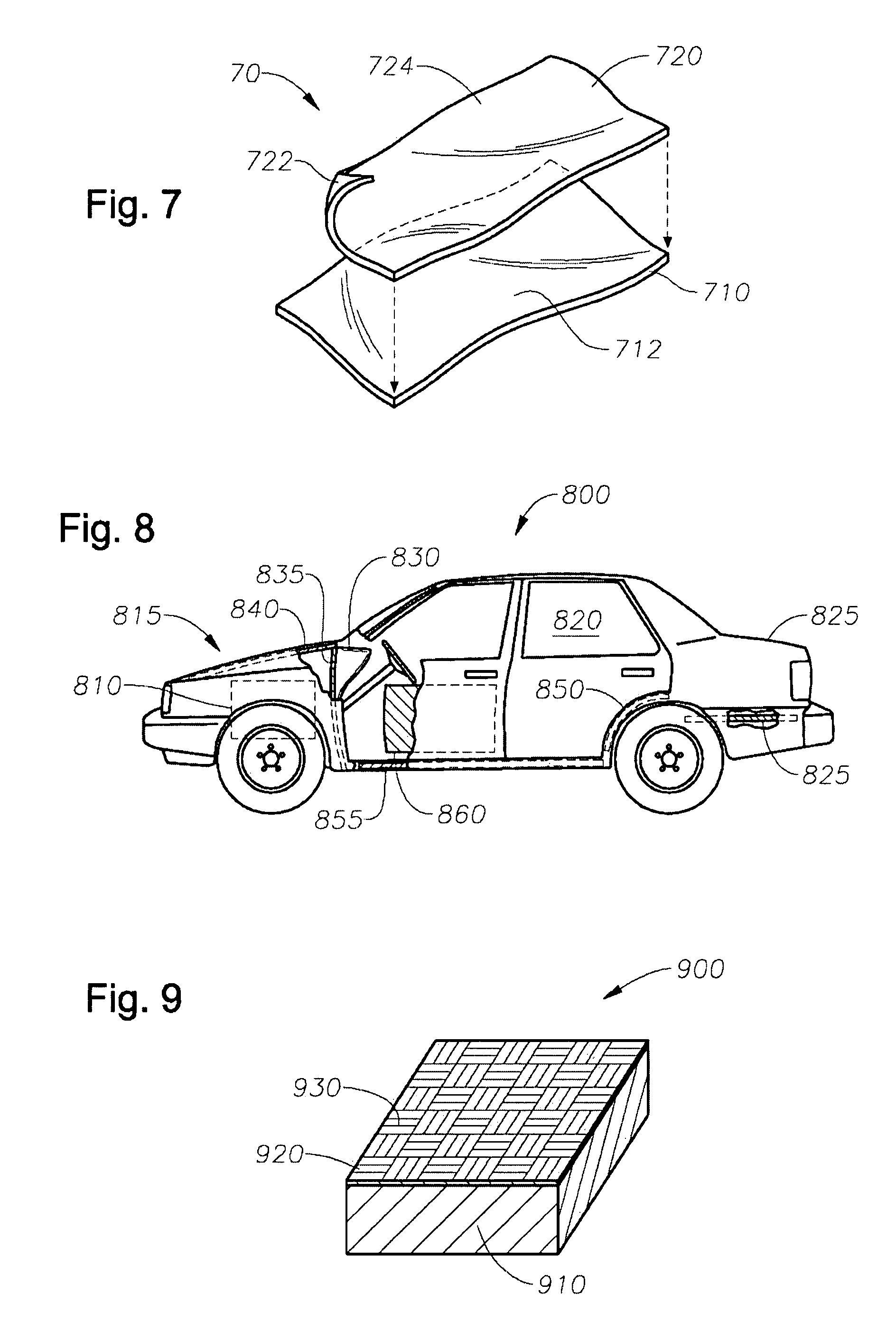Fire retardant nonwoven material and process for manufacture
a non-woven material, fire retardant technology, applied in the direction of synthetic resin layered products, flooring, textiles and paper products, etc., can solve the problems of limiting the actual thickness of insulating composites which can be used, the upper limit of insulating composite thickness, and contributing to the weight of the vehicl
- Summary
- Abstract
- Description
- Claims
- Application Information
AI Technical Summary
Benefits of technology
Problems solved by technology
Method used
Image
Examples
embodiment
Non-limiting Insulation Embodiment
[0216] According to another aspect of the present invention, the nonwoven materials can be pre-molded into articles that are intended to provide acoustic and thermal insulation in a building or the like. As shown in FIG. 9 and according to one exemplary embodiment, the nonwoven material is pre-molded into a ceiling tile 900 that has the desired acoustic and thermal insulation properties. The illustrated ceiling tile 900 is formed of a core 910 of the nonwoven material of the present invention in accordance with pad 10 of FIG. 1. The ceiling tile 900 further has an outer layer 920. It will be understood that the outer layer 920 is not a required element since the ceiling tile 900 can be formed of just the nonwoven materials of the present invention.
[0217] The outer layer 920 can be a decorative outer layer that is formed of a material that is different from the nonwoven material that makes up the core or base pad 910. For example, the outer layer 92...
examples
[0223] In connection with the following Examples and experiments, certain materials were used. While others materials are disclosed in the specification, the following list includes a summary of certain materials:
[0224] FOLEY FLUFFS® bleached Southern softwood Kraft from Buckeye Technologies Inc. of Memphis, Tenn. FOLEY FLUFFS® brand fibers are fabricated from cellulosic materials, primarily wood pulp from slash pine.
[0225] FFLE+ bleached and debonder-treated Southern softwood Kraft from Buckeye Technologies Inc. of Memphis, Tenn. FFLE+ represents another source of cellulosic fibers.
[0226] Trevira Type 255 Lot 1661 polyethylene sheath polyethylene therephthalate core, also referred to as PET or polyester, 2 dpf (denier per fiber) by 6 mm cut length synthetic bicomponent fiber from Trevira of Bobingen, Germany. This is a binder fiber having a core and sheath.
[0227] Cellutissue 3024 is an 18 gsm wet-laid tissue from Cellu Tissue Neenah of Neenah, Wis. may be used as a carrier shee...
examples 1-41
Introduction to Sample Pad Formation
[0285] A laboratory airlaid apparatus was used which lays down a 35.5 cm×35.5 cm (14 inch×14 inch) pad. This size of sample is often termed a “handsheet” and is suitable for range-finding experiments. A handsheet may be formed before going to an actual airlaid machine to produce a continuous web.
[0286] In operating the handsheet former, pre-weighed amounts of selected fibers are added to a mixing chamber where jets of air fluidize and mix the fibers. The mixing chamber thus forms a fluidized “cloud” of fibers. The cloud of fibers is pulled down onto a forming wire by a vacuum source. A tissue or other porous carrier sheet is used over the wire to minimize the loss of fiber to the vacuum system. While some automotive applications call for a spunbond slipsheet or carrier attached to one face of the acoustically insulating handsheet or test pad, in other instances the carrier may be removed before further processing and testing.
[0287] A cellulose ...
PUM
| Property | Measurement | Unit |
|---|---|---|
| weight percent | aaaaa | aaaaa |
| weight percent | aaaaa | aaaaa |
| thickness | aaaaa | aaaaa |
Abstract
Description
Claims
Application Information
 Login to View More
Login to View More - R&D
- Intellectual Property
- Life Sciences
- Materials
- Tech Scout
- Unparalleled Data Quality
- Higher Quality Content
- 60% Fewer Hallucinations
Browse by: Latest US Patents, China's latest patents, Technical Efficacy Thesaurus, Application Domain, Technology Topic, Popular Technical Reports.
© 2025 PatSnap. All rights reserved.Legal|Privacy policy|Modern Slavery Act Transparency Statement|Sitemap|About US| Contact US: help@patsnap.com



